Climate Change and Environment
Introduction
- Climate change is a prolonged change in weather and temperature patterns that can occur due to natural reasons.
- The global nature of the matter makes India one of the most critical countries though it contributed only about 4 % of the cumulative global emersion for 1850-2019.
- However, it has consistently demonstrated global leadership by taking various measures and ensuring a low-emission growth pathway with a pledge to the net-zero emissions goal by 2070.
Global Scenario
- As per UN SDG Portal, by 2030, more than 700 million people worldwide will be at risk of displacement by drought alone.
- As per the IPCC’s Sixth Assessment Report, global hotspots are found particularly in South Asia, West, Central & East Africa, Central, and South America, Small Island Developing States, and the Arctic.
- Many nations are committed to reducing their net emission to zero by 2050. Some countries wish to achieve it by 2060 and by 2070.

Domestic Scenario
- India is vulnerable due to its long coastline, monsoon-dependent agriculture, and large agrarian economy.
Progress On India’s Climate Action
- India launched National Action Plan on Climate Change in 2008, covering initiatives in the area of solar, energy efficiency, forests, water, sustainable agriculture, sustainable habitat, sustaining the Himalayan ecosystem, capacity building and research and development (R&D)
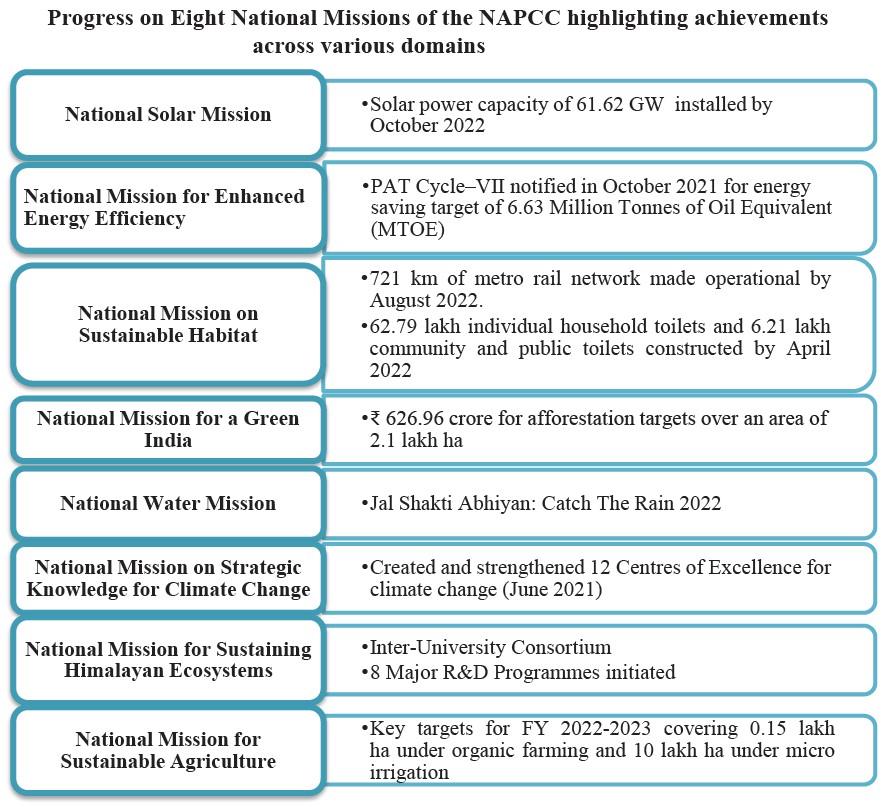
- Demonstrating a higher target in its climate action, the GOI submitted its updated NDC in compliance with article 4 of the Paris Agreement.
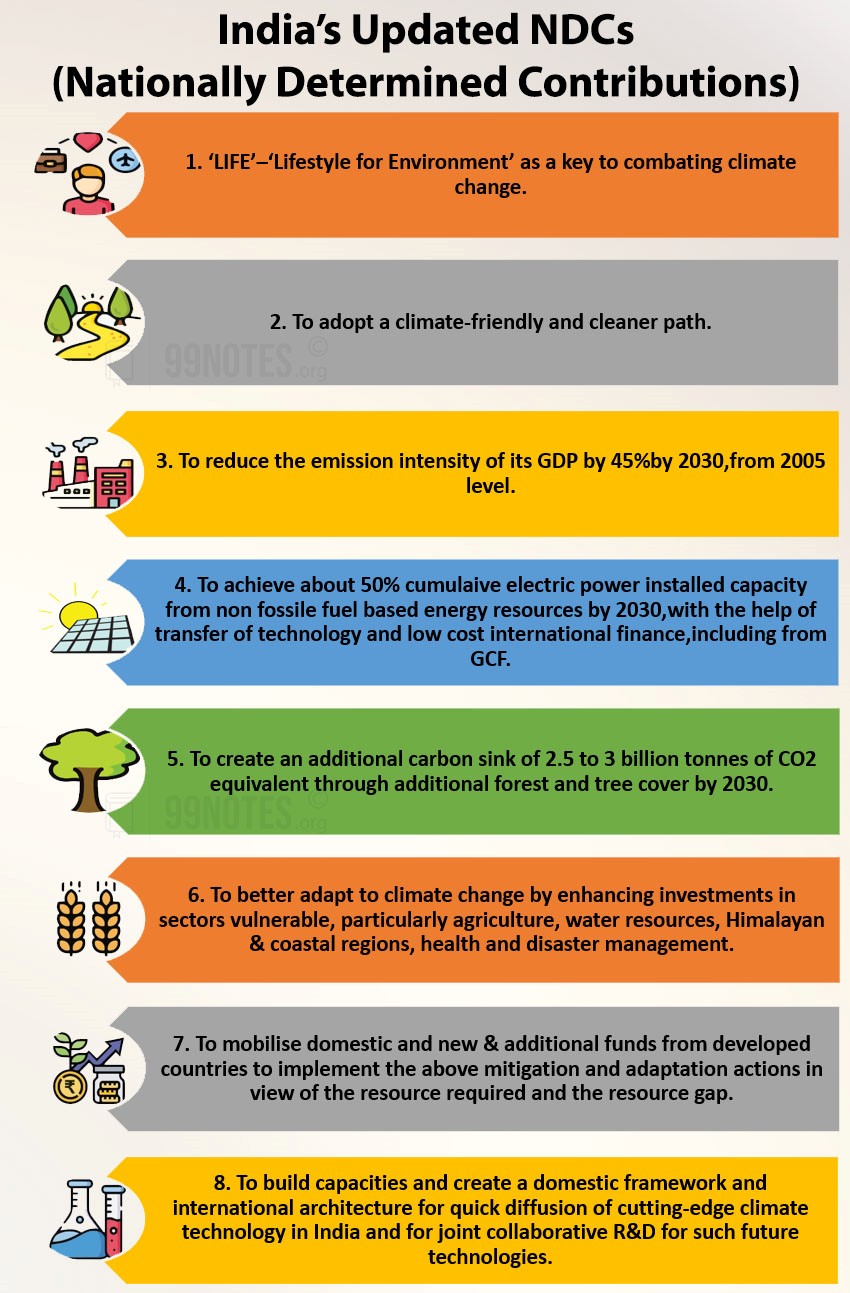
- Panchamrit Targets: The new NDC with ameliorated targets translates the idea of the Hon’ble PM expressed through the “Panchamrit” at the COP 26(UNFCCC) in Glasgow.
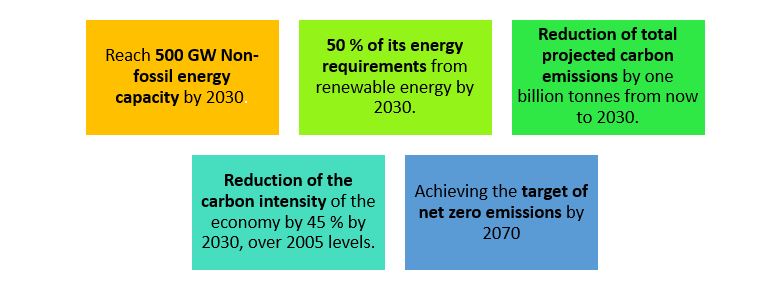
Status of Forest and tree Cover
- One of the 3 quantifiable targets of India’s NDC is to achieve an additional carbon sink of 5 to 3.0 billion tonnes through additional forest and tree cover by 2030.
- India ranks 3rd globally with respect to the net gain in average annual forest area between 2010-20.
- Schemes like the National Afforestation Programme (NAP), Green India Mission (GIM), Compensatory Afforestation Fund Management and Planning Authority (CAMPA), Green Highway Policy – 2015, Policy for Enhancement of Urban Greens, National Agro-Forestry Policy, and Sub-Mission on Agro-forestry (SMAF), etc., are amongst the most important.
Carbon Stock in India’s Forest and tree Cover
- Forest Survey of India has been assessing the carbon stock in India’s forests since 2011 biennially through its Indian State of Forest Report. Although, it released its first assessment in 2004.
- Carbon stock is the amount of carbon sequestrated from the atmosphere. It is stored in biomass(living matter), deadwood, soil, and litter in the forest.
- The Indian State of Forest Report estimates that the carbon stock of forests increased to 79.4 million tonnes as compared to the previous assessment for 2017. It has been rising continuously since 2011.

- The per-hectare forest carbon stock among different States/UTs indicates that Jammu & Kashmir is contributing the maximum per-hectare carbon stock, followed by Himachal Pradesh, Sikkim and Andaman & Nicobar Islands (162.9 tonnes).
- In absolute terms, Arunachal Pradesh has the maximum carbon stock, followed by Madhya Pradesh, among the Indian States.
Preservation of ecosystems: a Critical adaptation action
- Ecosystems play a significant role in carbon storage, protecting coastal areas, and enhancing water quality, besides a few other services like cultural, spiritual or tourist attractions.
- India is now home to 75 Ramsar sites for wetlands, 49 of which have been added in the last 8 years.
- The regulatory measures are implemented through Coastal Regulation Zone Notification (2019) under the Environment (Protection) Act, 1986; the Indian Forest Act, 1927; the Wild Life (Protection) Act, 1972; and the Biological Diversity Act, 2002.
- The Government has taken promotional and regulatory measures to protect and conserve mangroves. National Coastal Mission Programme on ‘Conservation and Management of Mangroves and Coral Reefs’ is being implemented for the same.
- As a result, India’s mangrove cover has been rising since 2021.
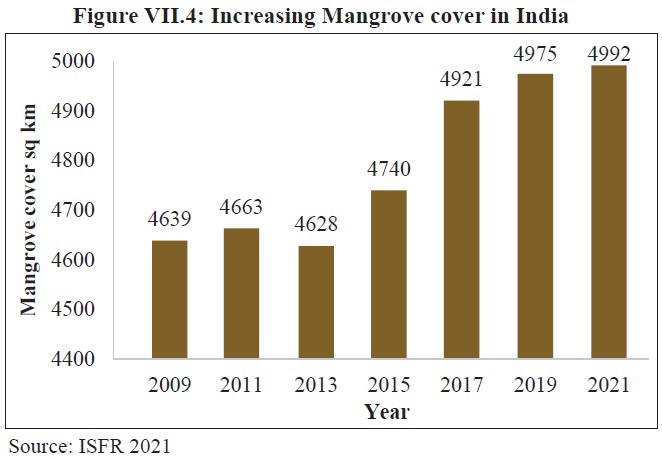
River Conservation and Rejuvenation
- The Government is working on mapping and converging the 5Ps – Plan, Policy, People, Programme and Project.
- The Government has taken measures to mark the polluted rivers in the country through the Namami Gange for River Ganga(including its tributaries) and the National River Conservation Plan for other rivers.
- The Government has also recently released Detailed Project Reports for rejuvenating 13 major rivers made by the Indian Council of Forestry Research and Education, Dehradun, in consultation with all the stakeholders.
Approach to transition to renewable energy Sources
- In the initial Nationally determined contribution(NDC) submitted in 2015, the target was to achieve 40% of the installed electric capacity from non-fossil fuel sources by 2030. This target has been achieved by now.
- India has now updated its NDCs, according to which India now aims to achieve the target of 50% cumulative electric power installed capacity from non-fossil fuel-based energy resources by 2030.
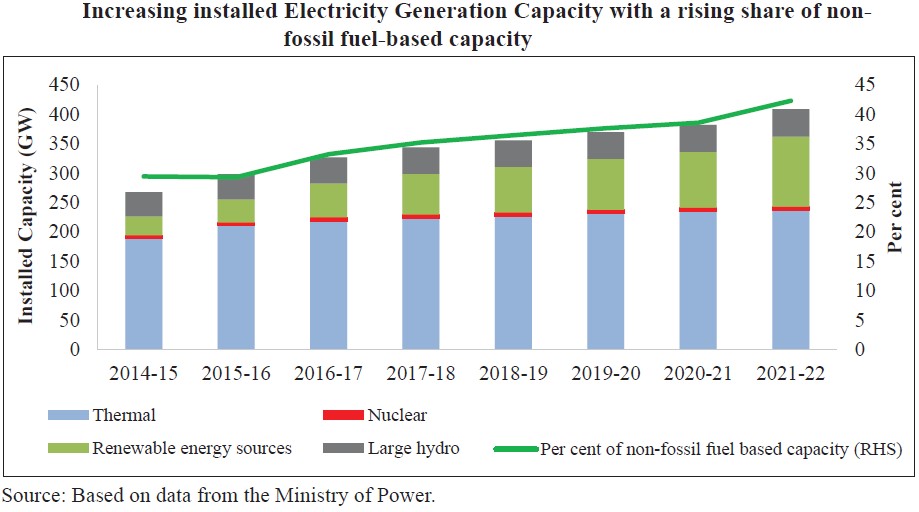
- The graph above shows that the growth in the Installed thermal capacity has practically halted, whereas renewable energy sources have been growing rapidly. Currently, the non-fossil fuel-based capacity stands above 40%.
- As per the Renewables 2022 Global Status Report, during 2014 -2021, total investment in renewables stood at US$ 78.1 billion in India.
- The Central Electricity Authority (CEA) has projected the optimal generation capacity mix to meet the peak electricity demand and electrical energy requirement for 2029-30.
- The likely installed capacity by the end of 2029-30 is expected to be more than 800GW, of which more than 500 GW would be from non-fossil fuels.
- The CEA has also estimated that the average emission rate will decline by around 29 % by 2029-30 compared to 2014-15.
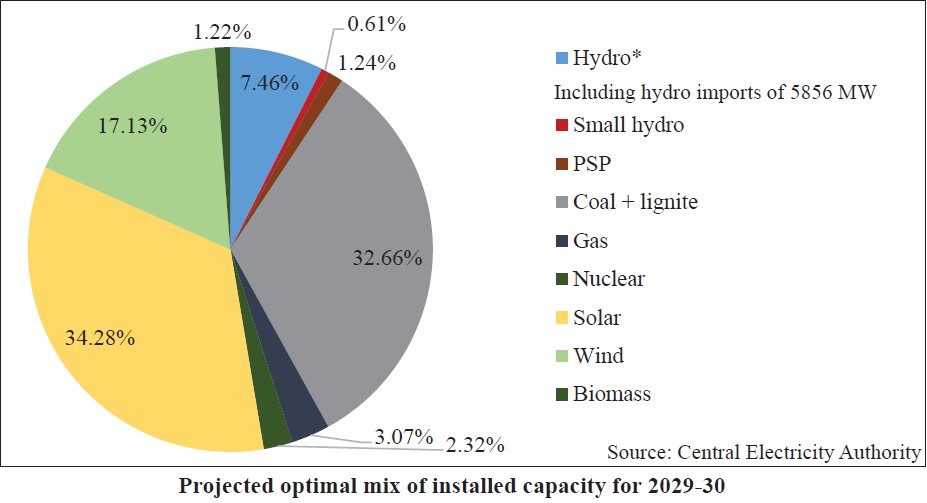
Green hydrogen-a critical source of alternate energy
- With a prospect to make India an energy-independent nation and de-carbonise critical sectors, the Government approved the National Green Hydrogen Mission on 4 January 2023.
- This Mission will facilitate demand creation, production, utilisation and export of Green Hydrogen and mobilisation of over ₹8 lakh crore of investment by 2030.
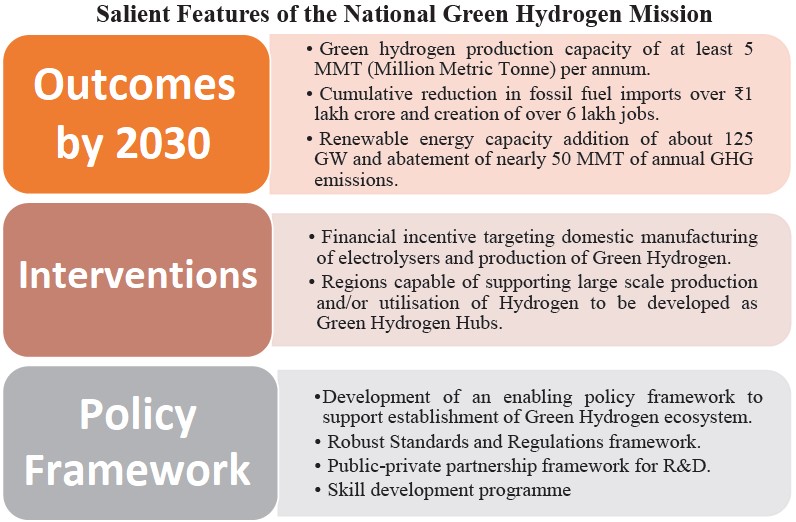
- As per NITI Aayog’s estimation, the cumulative value of the green hydrogen market in India will be US$ 8 billion by 2030 and US$ 340 billion by 2050.
- In addition, adopting green hydrogen will also result in 3.6 Giga tonnes of cumulative CO2 emission reduction by 2050.
- The study from NITI Aayog also shows that Green Hydrogen will become cheaper than Grey Hydrogen by 2030 (as shown in the chart below)
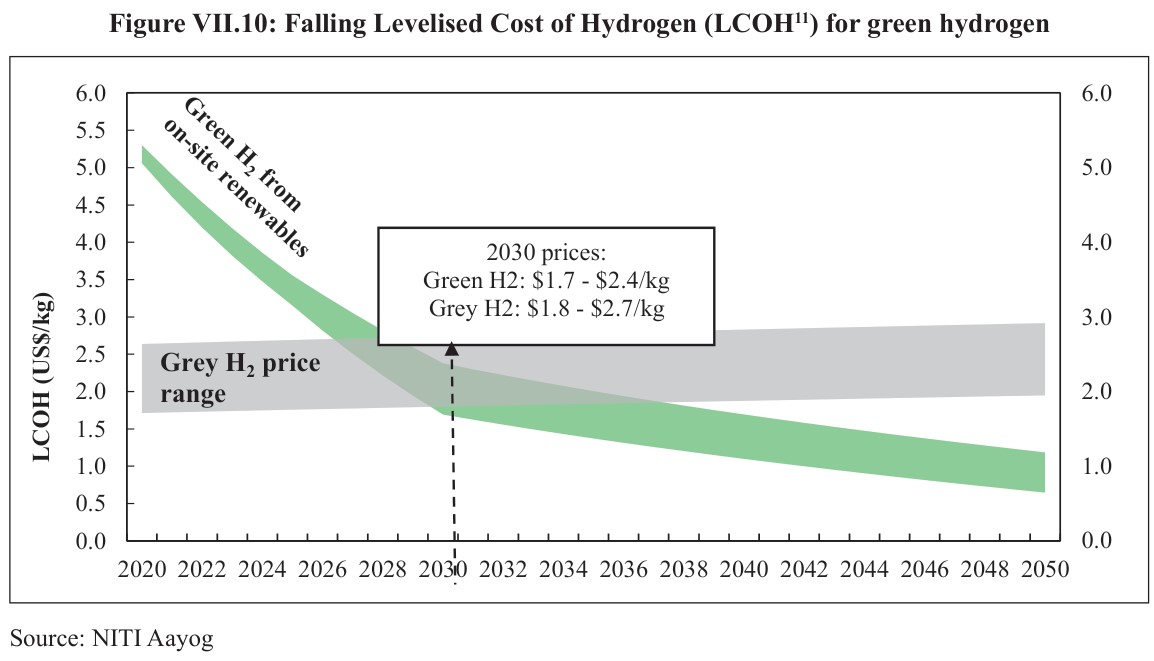
- However, all this is based on the assumption that access to critical minerals will continue to be available at a reasonable cost, which is vital for renewable energy.
| Critical minerals-Key to green transition |
| Critical minerals are the building blocks of essential modern-day technology and are at risk of supply chain disruption.
E.g., Cobalt, lithium, copper, nickel, and REEs are critical for producing EVs and batteries and harnessing solar power and wind energy. |
Long-term low emissions development Strategy (LT-LEDS)
- India submitted its LT-LEDS at COP 27.
| The salient features of LT-LEDS |
| 1. Focus on the rational utilisation of national resources regarding energy security. |
| 2. Encompasses the objectives of the National Hydrogen Policy. |
| 3. Increased use of biofuels, especially ethanol blending in petrol. |
| 4. Climate-resilient urban development will be driven by smart city initiatives, integrated planning of cities, enhancing energy and resource efficiency, effective green building codes and developments in innovative solid and liquid waste management. |
| 5. India’s industrial sector will continue on a strong growth path, with the vision of ‘Aatmanirbhar Bharat’ and ‘Make in India’. |
Finances for sustainable development
Green Bonds
- Green Bonds are financial instruments that acquire funds for investment in environmentally sustainable and climate-suitable projects.
- As per SEBI’s data on Green Bonds(Green Debt Securities), from 2017 to September 2022, 15 Indian corporates issued green bonds.
- In keeping with the ambition to significantly reduce the carbon intensity of the economy, the Union Budget 2022-23 announced the issue of Sovereign Green Bonds.
Investing in Resilience for Sustainable Development
- SEBI, the regulator of financial instruments like Green Bonds, has been one of the early adopters of sustainability reporting for listed entities and has required mandatory ESG-related disclosures for the top 100 listed entities (by market capitalisation) since 2012.
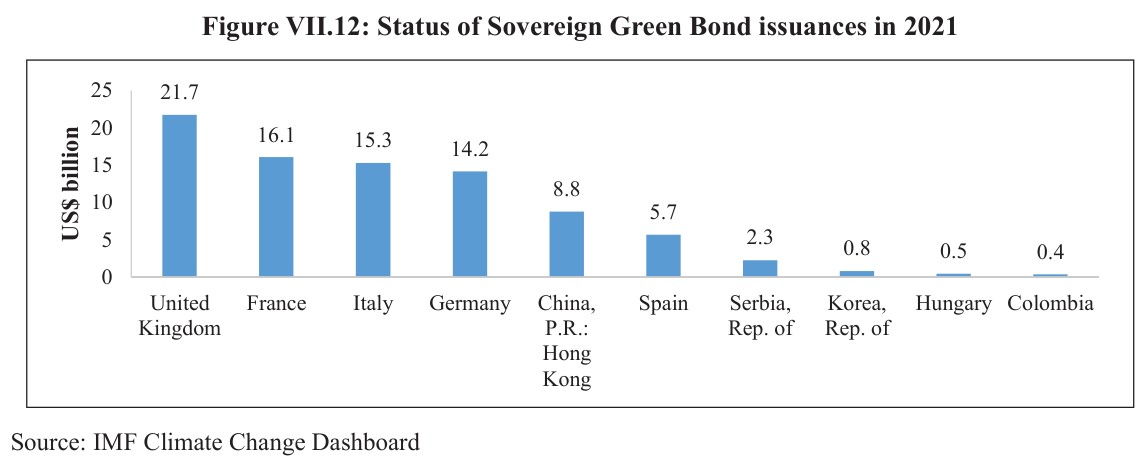
India’s initiatives at the International Stage
- International Solar Alliance (ISA).
- Coalition for Disaster Resilient Infrastructure.
- Leadership Group for Industry Transition (LeadIT).
Initiatives related to other environmental issues
- India ranks 8th in the world and 4th in Asia among the mega-diverse countries worldwide. It is very rich in fauna. Nearly 62% of India’s recorded amphibian species are endemic to India. These are majorly found in the Western Ghats.
- India holds the 8th position globally for origin and crop diversity. India has more than 300 wild ancestors and close relatives of cultivated plants growing naturally.
- In conformity with the spirit of the CBD, India enacted the Biological Diversity Act 2002.
- India and Nepal signed an MoU in August 2022 on biodiversity conservation to strengthen and enhance coordination and cooperation in the field of forests, environment, wildlife, biodiversity conservation, and climate change. It also includes the restoration of corridors and interlinking areas, and sharing knowledge/best practices between the two countries.
- Project Cheetah aims to introduce Cheetahs in India. It is the world’s first inter-continental large wild carnivore translocation project.
Wildlife – its Preservation and Protection
- India is home to 53 Tiger Reserves covering 18 States, hosting 75% of the world’s wild tiger population.
- India achieved the goal of doubling the tiger numbers in 2018, four years before the targeted year 2022.
- In addition, India’s 17 Tiger Reserves have CA|TS international accreditation, and two have received International Tx2 Award.
- Similarly, the population of Asiatic Lions has shown a steady increase, with a population of 674 individuals (2020), higher than the 523 lions in 2015.
- A 60% increase in population has been recorded in leopards.
- The current population estimates indicate about 50,000 – 60,000 Asian elephants worldwide. More than 60% of the population is in India.
- Indian Elephant has also been listed in Appendix-I of the Convention of the Migratory species in the Conference of Parties of CMS 13 at Gandhi
Nagar, Gujarat, in February 2020.
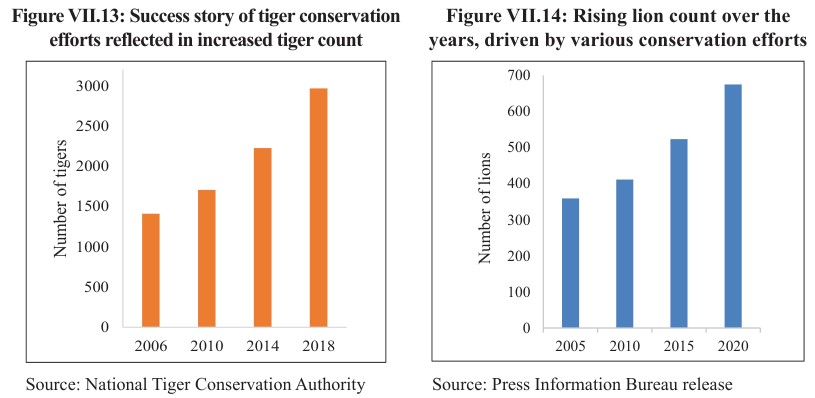
India takes other Environmental initiatives like
- Plastic Waste Management and Elimination of Identified Single-Use Plastics.
- The Battery Waste Management Rules, 2022.
- The E-Waste (Management) Rules, 2022.
Conclusion: India is leading one of the world’s most ambitious clean energy transitions. It remains committed to combating climate change despite the adverse impacts of Covid-19 on the economy. India has expanded its climate ambition manifold and is working on a long-term, multi-pronged approach by adopting a low GHG Emission Development Strategy.






